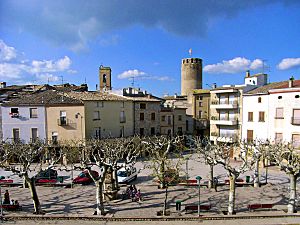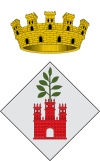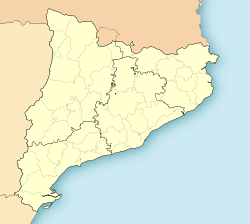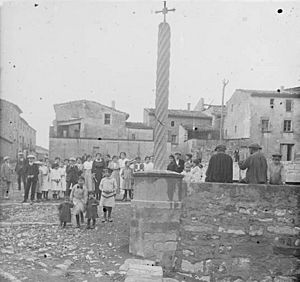Verdú facts for kids
Quick facts for kids
Verdú
|
||
|---|---|---|
|
Municipality
|
||

Plaça Major in Verdú
|
||
|
||
| Country | ||
| Autonomous community | ||
| Province | ||
| Comarca | ||
| Area | ||
| • Total | 35.8 km2 (13.8 sq mi) | |
| Population
(2018)
|
||
| • Total | 905 | |
| • Density | 25.28/km2 (65.47/sq mi) | |
| Time zone | UTC+1 (CET) | |
| • Summer (DST) | UTC+2 (CEST) | |
| Climate | Cfa | |
Verdú is a small town and municipality in Catalonia, Spain. It is located in the province of Lleida. Verdú is part of the Urgell area.
The town covers about 36 square kilometers. Its landscape has gentle hills, valleys, and flat areas. Farmers grow grains, grapes for wine, and olive and almond trees here. You can also find small forests of pine and oak trees. A canal called the Segarra-Garrigues canal and a highway both pass through the municipality.
Today, Verdú is famous for several things. It is known for its local wine and special black pottery. The town also has important old buildings like its Castle and the Church of Santa Maria. A famous person from Verdú is Saint Peter Claver. There was also a toy museum here, which is now an art gallery.
Contents
History of Verdú
The town of Verdú was first mentioned in a document from the year 1273. People believe its name comes from an old Celtic word, Virodunum. This word means "fortress," which is a strong, protected place.
For many centuries, Verdú was under the control of the Poblet monastery. This lasted from 1227 until 1835. The town's population was highest in 1887, with 2,185 people. However, it has since become smaller.
How Verdú Was Rebuilt
An important event in Verdú's history happened in 1184. A big flood destroyed most of the old town. Before the flood, people lived in a valley near a river. After the flood, the town's owner, Berengaria of Cervera, made a plan. She asked the villagers to move their homes to higher ground. This new area was around the castle, which had started being built a century earlier.
In return for moving, the villagers received new walls and gates for their town. Berengaria's son, Guillem of Cervera, later sold the town to the Poblet monastery. Being part of the monastery helped Verdú grow and become very successful. This is why you can still see grand buildings like the castle and the church today.
What Is Verdú's Economy Like?
The main parts of Verdú's economy are its pottery industry and farming.
Verdú's Pottery Industry
Verdú is famous for its traditional black pottery. They make special water jars called càntirs. This pottery tradition is very old, going back to Roman times. It has been recorded since the 1200s. Every year, Verdú celebrates this craft with the Firacàntir Festival. This festival happens on the last weekend of April.
Farming and Livestock
Farming in Verdú mainly involves growing crops without irrigation. Farmers grow grains like barley and wheat. They also grow grapes for wine, almonds, and olives. A local farming group helps produce olive oil. They also send grapes to wineries to make cava, a type of Spanish sparkling wine.
Raising animals is also important in Verdú. Farmers raise pigs, cattle, sheep, and rabbits. The town is a key place for livestock fairs, where animals are bought and sold.
Important Buildings in Verdú
Verdú has some amazing old buildings. The castle and the Church of Santa Maria are especially notable.
Verdú Castle
The castle is a very impressive building. It has a tall, round tower that is 25 meters high. This tower was built around the year 1080. Inside the castle, there are two rooms from the 11th century. The castle is special because it is the only Gothic castle in Catalonia with three large halls stacked on top of each other.
One of these halls, the Copons Abbot room, has been restored. It is a beautiful example of Catalan Civil Gothic style. Around the castle's main courtyard, there is a gallery with Renaissance stone steps. The basement of the castle was designed by Cesar Martinell. He was a student of the famous architect Antoni Gaudí. This part of the castle shows a modern style of architecture.
Church of Santa Maria
The Church of Santa Maria was built in the late 1200s. It was first built with a single main area, following a simple style. As the town grew, the church was made larger. The stone image of the Virgin Mary at the altar is from the 1400s. A famous painter from Lleida, Jaume Ferrer, created the altarpiece. This altarpiece is now in a museum in Vic.
The church was expanded to have three main areas. The central area has a slightly pointed arched ceiling. The other two areas show how they were built over time. A beautiful statue of the Immaculate Conception was made in 1623. Another important part is the area dedicated to Sant Flavia. Its altarpiece was lost during the Civil War. On the left side, there is a stone marking the church's dedication in 1586. This was done by Joan Terès i Borrull, who was from Verdú.
The church also holds a very special image of St. Christ. This image is from the late 1200s or early 1300s. People in Verdú prayed to it during times of drought or sickness. Paintings on the altar were added in the 1950s by Jaume Minguell. More recently, in 2004, new stained-glass windows were added. These windows honor Sant Flavia, St. Peter Claver, and St. Hippolytus. A large round window also celebrates the town of Verdú.
Images for kids
See also
 In Spanish: Verdú para niños
In Spanish: Verdú para niños





